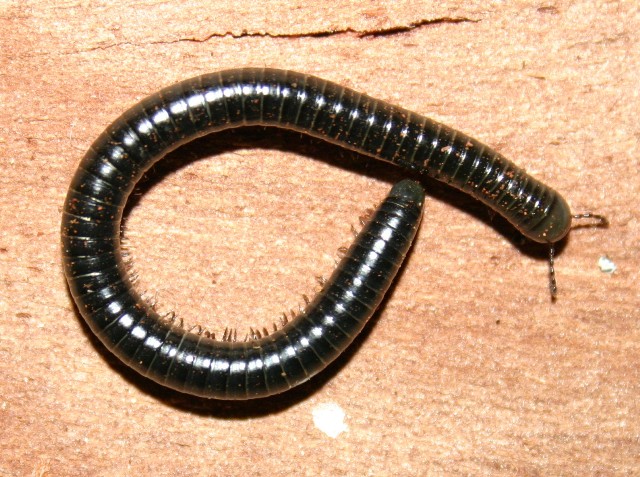Phylum Arthropoda
Subphylum Myriapoda
Class Diplopoda
Order Spirostreptida
Common name: spirosteptid millipedes
Overview
Spirostreptids typically have a cylindrical body form, and vary enormously in size, from about 6 mm to over 300 mm. The body segments are often numerous, up to 90 segments, and each is consists of a ring-like sclerite, resulting from the fusion of the tergites, pleurites and sternites. The first pair of legs are modified into secondary sexual structures. Both pairs of legs on segment seven are modified into gonopods, of which the anterior most pair are the most active. Spirostreptid millipedes possess repugnatory glands and some are able to squirt or spray these defensive compounds over distances of 250-300 mm. The defensive compounds released from the repugnatory glands of some species are known to cause severe skin irritation to people.
Distribution and Diversity
Spirostreptids typically have a cylindrical body form, and vary enormously in size, from about 6 mm to over 300 mm. The body segments are often numerous, up to 90 segments, and each is consists of a ring-like sclerite, resulting from the fusion of the tergites, pleurites and sternites. The first pair of legs are modified into secondary sexual structures. Both pairs of legs on segment seven are modified into gonopods, of which the anterior most pair are the most active. Spirostreptid millipedes possess repugnatory glands and some are able to squirt or spray these defensive compounds over distances of 250-300 mm. The defensive compounds released from the repugnatory glands of some species are known to cause severe skin irritation to people.
Life cycle
Spirostreptids typically have a cylindrical body form, and vary enormously in size, from about 6 mm to over 300 mm. The body segments are often numerous, up to 90 segments, and each is consists of a ring-like sclerite, resulting from the fusion of the tergites, pleurites and sternites. The first pair of legs are modified into secondary sexual structures. Both pairs of legs on segment seven are modified into gonopods, of which the anterior most pair are the most active. Spirostreptid millipedes possess repugnatory glands and some are able to squirt or spray these defensive compounds over distances of 250-300 mm. The defensive compounds released from the repugnatory glands of some species are known to cause severe skin irritation to people.
Feeding
Spirostreptid millipedes are thought to consume decomposing vegetation and fungi, however some species may also consume green vegetation.
Ecology
Spirostreptid millipedes are found in moist habitats, and are frequently encountered under stones, logs, bark and in leaf litter.

Atelomastix sp. from Two Peoples Bay, Western Australia
Image credit: Photographer: Mark Harvey
� Western Australian Museum

Species of Lulomorphidae
Image credit: Photographer: Mark Harvey
� Western Australian Museum








